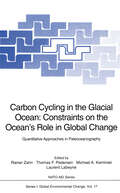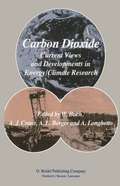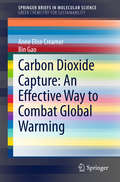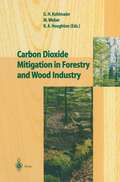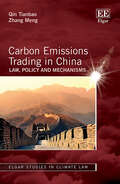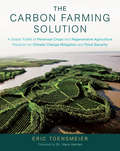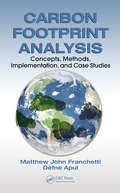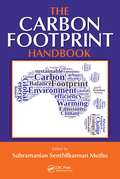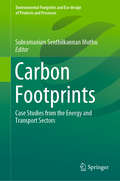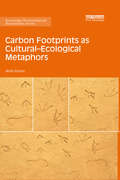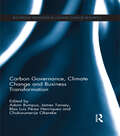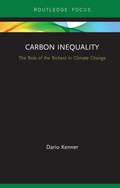- Table View
- List View
Carbon Cycling in Northern Peatlands (Geophysical Monograph Series #184)
by Andrew J. Baird Lisa R. Belyea Belyea Xavier Comas A. S. Reeve Lee D. SlaterPublished by the American Geophysical Union as part of the Geophysical Monograph Series, Volume 184.Carbon Cycling in Northern Peatlands examines the role that northern peatlands play in regulating the atmospheric carbon budget. It summarizes current research in four interconnected areas: large-scale peatland dynamics and carbon cycling; plant and microbial dynamics and their effect on carbon fluxes to the atmosphere; methane accumulation in, and loss from, peatlands; and water and dissolved carbon fluxes through peatlands. The volume highlights include A thorough assessment of the challenges involved in incorporating carbon cycling in northern peatlands into global climate models; A conceptual model to examine the partitioning of terminal carbon mineralization into production of CO2 and CH4; A comprehensive review of the evidence for the accumulation of methane in deep and shallow peat; and A description of the hydrologic changes induced by peat harvesting and associated challenges in restoring altered peatlands to their natural hydrologic regime. Carbon Cycling in Northern Peatlands will be of interest to research scientists and graduate and undergraduate students, particularly those who wish to know more about the role of peatlands in the global carbon cycle and their role as modifiers of climate.
Carbon Cycling in Northern Peatlands (Geophysical Monograph Series #184)
by Andrew J. Baird Lisa R. Belyea Xavier Comas A. S. Reeve Lee D. SlaterPublished by the American Geophysical Union as part of the Geophysical Monograph Series, Volume 184.Carbon Cycling in Northern Peatlands examines the role that northern peatlands play in regulating the atmospheric carbon budget. It summarizes current research in four interconnected areas: large-scale peatland dynamics and carbon cycling; plant and microbial dynamics and their effect on carbon fluxes to the atmosphere; methane accumulation in, and loss from, peatlands; and water and dissolved carbon fluxes through peatlands. The volume highlights include A thorough assessment of the challenges involved in incorporating carbon cycling in northern peatlands into global climate models; A conceptual model to examine the partitioning of terminal carbon mineralization into production of CO2 and CH4; A comprehensive review of the evidence for the accumulation of methane in deep and shallow peat; and A description of the hydrologic changes induced by peat harvesting and associated challenges in restoring altered peatlands to their natural hydrologic regime. Carbon Cycling in Northern Peatlands will be of interest to research scientists and graduate and undergraduate students, particularly those who wish to know more about the role of peatlands in the global carbon cycle and their role as modifiers of climate.
Carbon Cycling in the Baltic Sea (GeoPlanet: Earth and Planetary Sciences)
by Karol Kulinski Janusz PempkowiakThe Baltic Sea is an area extensively explored by the oceanographers. Hence it is one of the most often described marine areas in the scientific literature. However, there are still several fields which are poorly investigated and reported by scientists. One of them is the carbon cycle of the Baltic Sea. Although it is believed the shelf seas are responsible for about 20% of all marine carbon dioxide uptake, while they constitute only 7% of the whole sea surface, still a scientific debate exists on the role of the Baltic Sea in the global carbon cycle. “Carbon cycle of the Baltic Sea” is intended to be a comprehensive presentation and discussion of state of the art research by biogeochemists involved in the Baltic Sea carbon cycle research. This work presents both qualitative and quantitative descriptions of the main carbon flows in the Baltic Sea as well as their possible shifts induced by climatic and global change.
Carbon Cycling in the Glacial Ocean: Quantitative Approaches in Paleoceanography (Nato ASI Subseries I: #17)
by Rainer Zahn Thomas F. Pedersen Michael A. Kaminski Laurent LabeyrieA comprehensive progress report on the multi-disciplinary field of ocean and climate change research is given. It compiles introductory background papers and leading scientific results on the ocean-atmosphere carbon cycle with emphasis on the ocean's carbon inventory and the various components involved. The relationship between plankton productivity, carbon fixation, oceanic PCO2 and climate change is investigated from the viewpoint of long-term climatic change during the late Quaternary cycles of ice ages and warm ages. The various approaches range from micropaleontology over organic and trace element geochemistry to molecular isotope geochemistry.
Carbon Dioxide: Current Views and Developments in Energy/Climate Research 2nd Course of the International School of Climatology, Ettore Majorana Centre for Scientific Culture, Erice, Italy, July 16–26, 1982
by W. Bach A. J. Crane A. L. Berger A. LonghettoThe International School of Climatology of the "Ettore Majo rana Centre for Scientific Culture" at Erice was founded in 1979, with the aim of organising advanced courses and highly specialized seminars on current problems in the field of climatology. The first course, in March 1980, was devoted to climatic varia tions and variability, the understanding of which lies at the roots of modern climatological research. The publicity given to recent extremes of climate, which have had serious consequences for local populations, has led to an increased awareness of the practical importance of researching the causes and nature of climatic changes on all temporal and spatial scales. In recent decades it has become apparent that man himself is capable, mostly through industrial and agricultural activities, of causing climatic perturbations on both the local and global scales. Although these influences are as yet difficult to detect, it is clear that increasing release of C02 through the expanding use of fossil fuels for energy production is one activity that could lead to significant climatic change. Indeed, by this means, energy use has the potential of being the major influence on climate over the next century, so the choice of this aspect of climate-ener gy interactions as the topic of the Second Course of the Interna tional School of Climatology was an obvious one. It took place from 16 - 26 July, 1982.
Carbon Dioxide Capture: An Effective Way to Combat Global Warming (SpringerBriefs in Molecular Science)
by Anne Elise Creamer Bin GaoThis topical brief summarizes the various options available for carbon capture and presents the current strategies involved in CO2 reduction. The authors focus on current CO2 capture technologies that facilitate the reduction of greenhouse gas (CO2) emissions and reduce global warming. This short study will interest environmental researchers, teachers and students who have an interest in global warming.
Carbon Dioxide Equilibria and Their Applications
by James N. ButlerCarbon dioxide, bicarbonate ion, and carbonate ion comprise the most important acid-base system in natural waters, and the equilibria between them regulate the pH of seawater, as well as most rainwater, stream water, river water, and groundwater. Carbon Dioxide Equilibria and Their Applications provides a clear, compact presentation of this topic,
Carbon Dioxide Equilibria and Their Applications
by James N. ButlerCarbon dioxide, bicarbonate ion, and carbonate ion comprise the most important acid-base system in natural waters, and the equilibria between them regulate the pH of seawater, as well as most rainwater, stream water, river water, and groundwater. Carbon Dioxide Equilibria and Their Applications provides a clear, compact presentation of this topic,
Carbon Dioxide Mitigation in Forestry and Wood Industry
by Gundolf H. Kohlmaier Michael Weber Richard A. HoughtonThe lntergovernmental Panel on Climate Change (IPCC) has recently summarized the state ofthe art in research on climate change (Climate Change 1995). The most up to date research findings have been divided into three volumes: • the Science ofClimate Change (working group I), • the Impacts, Adaption and Mitigation of Climate Change (working group II), and • the Economic and Social Dimensions ofClimate Change (working group III) There is a general consensus that a serious change in climate can only be avoided if the future emissions of greenhouse gases are reduced considerably from the business as usual projection and if at the same time the natural sinks for greenhouse gases, in particular that of CO , are maintained at the present level or 2 preferrably increased. Forests, forestry and forestry industry are important parts of the global carbon cycle and therefore they are also part of the mitigation potentials in at least a threefold way: 1. During the time period between 1980 and 1989 there was a net emission of CO from changes in tropical land use (mostly tropical deforestation) of 2 1. 6 +/- 1 GtC/a, but at the same time it was estimated that the forests in the northem hemisphere have taken up 0. 5 +/- 0. 5 GtC/a and additionally other terrestrial sinks (including tropical forests where no clearing took place) have been a carbon sink ofthe order of l. 3 +/- l.
Carbon Dioxide through the Ages: From wild spirit to climate culprit
by Han DolmanCarbon dioxide has become one of the “defining molecules” of our century, due to its role in Earth's climate. This text traces the development of the perception of carbon dioxide through the ages. With layman summaries at the beginning of each chapter and extensive literature references and notes, the text takes the reader through the history of our understanding of the gas, from its early discovery as a separate gas in the mid-17th century to the recognition of its radiative properties and impact on climate in the late 19th and 20th century. The text describes the world's slow efforts to control the rise in carbon dioxide over the last 50 years and concludes by setting the stage for the Paris climate accords and subsequent negotiations. The world must reduce the emissions of carbon dioxide fast, and this book discusses options to achieve that goal. Han Dolman is a climate scientist and director of the Royal NIOZ, the Netherlands Institute for Sea Research, as well as a Professor at the Department of Earth Sciences, Free University of Amsterdam. For many years, his work has been centered around the global carbon cycle and its relation to our climate. Over the length of his career, he has been involved in several international research programs such as the Global Climate Observing System.
Carbon Dioxide through the Ages: From wild spirit to climate culprit
by Han DolmanCarbon dioxide has become one of the “defining molecules” of our century, due to its role in Earth's climate. This text traces the development of the perception of carbon dioxide through the ages. With layman summaries at the beginning of each chapter and extensive literature references and notes, the text takes the reader through the history of our understanding of the gas, from its early discovery as a separate gas in the mid-17th century to the recognition of its radiative properties and impact on climate in the late 19th and 20th century. The text describes the world's slow efforts to control the rise in carbon dioxide over the last 50 years and concludes by setting the stage for the Paris climate accords and subsequent negotiations. The world must reduce the emissions of carbon dioxide fast, and this book discusses options to achieve that goal. Han Dolman is a climate scientist and director of the Royal NIOZ, the Netherlands Institute for Sea Research, as well as a Professor at the Department of Earth Sciences, Free University of Amsterdam. For many years, his work has been centered around the global carbon cycle and its relation to our climate. Over the length of his career, he has been involved in several international research programs such as the Global Climate Observing System.
Carbon Emissions in China (Springer Theses)
by Zhu LiuThis study analyzes the spatial-temporal pattern and processes of China’s energy-related carbon emissions. Based on extensive quantitative analysis, it outlines the character and trajectory of China’s energy-related carbon emissions during the period 1995-2010, examining the distribution pattern of China’s carbon emissions from regional and sectoral perspectives and revealing the driving factors of China’s soaring emission increase. Further, the book investigates the supply chain carbon emissions (the carbon footprints) of China’s industrial sectors. Anthropogenic climate change is one of the most serious challenges currently facing humankind. China is the world’s largest developing country, top primary energy consumer and carbon emitter. Achieving both economic growth and environmental conservation is the country’s twofold challenge. Understanding the status, features and driving forces of China’s energy-related carbon emissions is a critical aspect of attaining global sustainability. This work, for the first time, presents both key findings on and a systematic evaluation of China’s carbon emissions from energy consumption. The results have important implications for global carbon budgets and burden-sharing with regard to climate change mitigation. The book will be of great interest to readers around the world, as it addresses a topic of truly global significance.
Carbon Emissions Trading in China: Law, Policy and Mechanisms (Elgar Studies in Climate Law)
by Qin Tianbao Zhang MengEmissions Trading Systems (ETS) have been hailed as a game changer for the evolving climate crisis. This book provides an in-depth analysis of China’s carbon ETS, including its legal and policy frameworks, carbon market mechanisms, and international and comparative implications.With nine cutting-edge topics divided into three thematic parts, this comprehensive book probes the essential concepts, contemporary research, and key elements of carbon emissions trading in China. Multidisciplinary in scope, the book draws on insights from law, policy, economics, environmental management, and geopolitics, to provide a comprehensive and nuanced analysis of the development of carbon emissions trading in China. Placing China’s carbon ETS within the broader context of international efforts to address climate change, it provides a comparative perspective with international value.This book will be an essential resource for scholars and researchers of international and comparative climate law and policy, environmental management, economics, and climate politics. It will prove an indispensable guide for students of Chinese law, climate law, environmental policy, and comparative environmental law. Practitioners, policymakers, and government officials working in climate governance seeking the state-of-the-art of the development of ETS in China will also benefit greatly from its insights.
The Carbon Farming Solution: A Global Toolkit of Perennial Crops and Regenerative Agriculture Practices for Climate Change Mitigation and Food Security
by Eric Toensmeier Dr Hans HerrenWith carbon farming, agriculture ceases to be part of the climate problem and becomes a critical part of the solution Agriculture is rightly blamed as a major culprit of our climate crisis. But in this groundbreaking new book, Eric Toensmeier argues that agriculture—specifically, the subset of practices known as “carbon farming”—can, and should be, a linchpin of a global climate solutions platform. Carbon farming is a suite of agricultural practices and crops that sequester carbon in the soil and in above-ground biomass. Combined with a massive reduction in fossil fuel emissions—and in concert with adaptation strategies to our changing environment— carbon farming has the potential to bring us back from the brink of disaster and return our atmosphere to the “magic number” of 350 parts per million of carbon dioxide. Toensmeier’s book is the first to bring together these powerful strategies in one place, including in-depth analysis of the available research and, where research is lacking, a discussion of what it will take to get us there. Carbon farming can take many forms. The simplest practices involve modifications to annual crop production. Although many of these modifications have relatively low sequestration potential, they are widely applicable and easily adopted, and thus have excellent potential to mitigate climate change if practiced on a global scale. Likewise, grazing systems such as silvopasture are easily replicable, don’t require significant changes to human diet, and—given the amount of agricultural land worldwide that is devoted to pasture—can be important strategies in the carbon farming arsenal. But by far, agroforestry practices and perennial crops present the best opportunities for sequestration. While many of these systems are challenging to establish and manage, and would require us to change our diets to new and largely unfamiliar perennial crops, they also offer huge potential that has been almost entirely ignored by climate crusaders. Many of these carbon farming practices are already implemented globally on a scale of millions of hectares. These are not minor or marginal efforts, but win-win solutions that provide food, fodder, and feedstocks while fostering community self-reliance, creating jobs, protecting biodiversity, and repairing degraded land—all while sequestering carbon, reducing emissions, and ultimately contributing to a climate that will remain amenable to human civilization. Just as importantly to a livable future, these crops and practices can contribute to broader social goals such as women’s empowerment, food sovereignty, and climate justice. The Carbon Farming Solution does not present a prescription for how cropland should be used and is not, first and foremost, a how-to manual, although following up on references in a given section will frequently provide such information. Instead, The Carbon Farming Solution is—at its root—a toolkit. It is the most complete collection of climate-friendly crops and practices currently available. With this toolkit, farmers, communities, and governments large and small, can successfully launch carbon farming projects with the most appropriate crops and practices to their climate, locale, and socioeconomic needs. Toensmeier’s ultimate goal is to place carbon farming firmly in the center of the climate solutions platform, alongside clean solar and wind energy. With The Carbon Farming Solution, Toensmeier wants to change the discussion, impact policy decisions, and steer mitigation funds to the research, projects, and people around the world who envision a future where agriculture becomes the protagonist in this fraught, urgent, and unprecedented drama of our time. Citizens, farmers, and funders will be inspired to use the tools presented in this important new book to transform degraded lands around the world into productive carbon-storing landscapes.
Carbon Footprint Analysis: Concepts, Methods, Implementation, and Case Studies
by Matthew John Franchetti Defne ApulThe negative impacts of carbon emissions from human activities continue to dramatically reshape the environmental, political, and social landscape. These impacts coupled with cap and trade schemes iterate the importance and need to properly measure and reduce greenhouse gas emissions. Carbon Footprint Analysis: Concepts, Methods, Implementation, an
The Carbon Footprint Handbook
by Subramanian Senthilkannan MuthuThorough and detailed, The Carbon Footprint Handbook encompasses all areas of carbon footprint, including the scientific elements, methodological and technological aspects, standards, industrial case studies, and communication of carbon footprint results. Written and edited by an international group of experts, the far-ranging topics on carbon foot
Carbon Footprints: Industrial Case Studies (EcoProduction)
by Subramanian Senthilkannan MuthuThis book presents revealing case studies on carbon footprint calculation and mitigation in various industrial sectors. There are numerous sectors whose carbon footprints need to be calculated, and effective ways to mitigate the greenhouse-gas emissions from these sectors need to be found. Using representative case studies, this book highlights the carbon footprint of national power generation systems, crude glycerol production plants and the Brazilian highway network system, as well as the integration of renewable energy sources in expansion planning, so as to promote and implement power system decarbonization.
Carbon Footprints as Cultural-Ecological Metaphors (Routledge Environmental Humanities)
by Anita GirvanThrough an examination of carbon footprint metaphors, this books demonstrates the ways in which climate change and other ecological issues are culturally and materially constituted through metaphor. The carbon footprint metaphor has achieved a ubiquitous presence in Anglo-North American public contexts since the turn of the millennium, yet this metaphor remains under-examined as a crucial mediator of political responses to the urgent crisis of climate change. Existing books and articles on the carbon footprint typically treat this metaphor as a quantifying metric, with little attention to the shifting mediations and practices of the carbon footprint as a metaphor. This gap echoes a wider gap in understanding metaphors as key figures in mediating more-than-human relations at a time when such relations profoundly matter. As a timely intervention, this book addresses this gap by using insights from environmental humanities and political ecology to discuss carbon footprint metaphors in popular and public texts. This book will be of great interest to researchers and students of environmental humanities, political ecology, environmental communication, and metaphor studies.
Carbon Footprints as Cultural-Ecological Metaphors (Routledge Environmental Humanities)
by Anita GirvanThrough an examination of carbon footprint metaphors, this books demonstrates the ways in which climate change and other ecological issues are culturally and materially constituted through metaphor. The carbon footprint metaphor has achieved a ubiquitous presence in Anglo-North American public contexts since the turn of the millennium, yet this metaphor remains under-examined as a crucial mediator of political responses to the urgent crisis of climate change. Existing books and articles on the carbon footprint typically treat this metaphor as a quantifying metric, with little attention to the shifting mediations and practices of the carbon footprint as a metaphor. This gap echoes a wider gap in understanding metaphors as key figures in mediating more-than-human relations at a time when such relations profoundly matter. As a timely intervention, this book addresses this gap by using insights from environmental humanities and political ecology to discuss carbon footprint metaphors in popular and public texts. This book will be of great interest to researchers and students of environmental humanities, political ecology, environmental communication, and metaphor studies.
Carbon Governance, Climate Change and Business Transformation (Routledge Advances in Climate Change Research)
by Adam G. Bumpus James Tansey Blas L. Pérez Henríquez Chukwumerije OkerekeTransformation to a low carbon economy is a central tenet to any discussion on the solutions to the complex challenges of climate change and energy security. Despite advances in policy, carbon management and continuing development of clean technology, fundamental business transformation has not occurred because of multiple political, economic, social and organisational issues. Carbon Governance, Climate Change and Business Transformation is based on leading academic and industry input, and three international workshops focused on low carbon transformation in leading climate policy jurisdictions (Canada, USA and the UK) under the international Carbon Governance Project (CGP) banner. The book pulls insights from this innovative collaborative network to identify the policy combinations needed to create transformative change. It explores fundamental questions about how governments and the private sector conceptualize the problem of climate change, the conditions under which business transformation can genuinely take place and key policy and business innovations needed. Broadly, the book is based on emerging theories of multi-levelled, multi-actor carbon governance, and applies these ideas to the real world implications for tackling climate change through business transformation. Conceptually and empirically, this book stimulates both academic discussion and practical business models for low carbon transformation.
Carbon Governance, Climate Change and Business Transformation (Routledge Advances in Climate Change Research)
by Adam Bumpus James Tansey Chukwumerije Okereke Blas Luis Pérez HenríquezTransformation to a low carbon economy is a central tenet to any discussion on the solutions to the complex challenges of climate change and energy security. Despite advances in policy, carbon management and continuing development of clean technology, fundamental business transformation has not occurred because of multiple political, economic, social and organisational issues. Carbon Governance, Climate Change and Business Transformation is based on leading academic and industry input, and three international workshops focused on low carbon transformation in leading climate policy jurisdictions (Canada, USA and the UK) under the international Carbon Governance Project (CGP) banner. The book pulls insights from this innovative collaborative network to identify the policy combinations needed to create transformative change. It explores fundamental questions about how governments and the private sector conceptualize the problem of climate change, the conditions under which business transformation can genuinely take place and key policy and business innovations needed. Broadly, the book is based on emerging theories of multi-levelled, multi-actor carbon governance, and applies these ideas to the real world implications for tackling climate change through business transformation. Conceptually and empirically, this book stimulates both academic discussion and practical business models for low carbon transformation.
Carbon in Earth's Interior (Geophysical Monograph Series #250)
by Craig E. Manning Jung-Fu Lin Wendy L. MaoExplores the behavior of carbon in minerals, melts, and fluids under extreme conditions Carbon trapped in diamonds and carbonate-bearing rocks in subduction zones are examples of the continuing exchange of substantial carbon between Earth’s surface and its interior. However, there is still much to learn about the forms, transformations, and movements of carbon deep inside the Earth. Carbon in Earth's Interior presents recent research on the physical and chemical behavior of carbon-bearing materials and serves as a reference point for future carbon science research. Volume highlights include: Data from mineral physics, petrology, geochemistry, geophysics, and geodynamics Research on the deep carbon cycle and carbon in magmas or fluids Dynamics, structure, stability, and reactivity of carbon-based natural materials Properties of allied substances that carry carbon Rates of chemical and physical transformations of carbon The American Geophysical Union promotes discovery in Earth and space science for the benefit of humanity. Its publications disseminate scientific knowledge and provide resources for researchers, students, and professionals.
Carbon in Earth's Interior (Geophysical Monograph Series #250)
by Craig Manning Jung-Fu Lin Wendy MaoExplores the behavior of carbon in minerals, melts, and fluids under extreme conditions Carbon trapped in diamonds and carbonate-bearing rocks in subduction zones are examples of the continuing exchange of substantial carbon between Earth’s surface and its interior. However, there is still much to learn about the forms, transformations, and movements of carbon deep inside the Earth. Carbon in Earth's Interior presents recent research on the physical and chemical behavior of carbon-bearing materials and serves as a reference point for future carbon science research. Volume highlights include: Data from mineral physics, petrology, geochemistry, geophysics, and geodynamics Research on the deep carbon cycle and carbon in magmas or fluids Dynamics, structure, stability, and reactivity of carbon-based natural materials Properties of allied substances that carry carbon Rates of chemical and physical transformations of carbon The American Geophysical Union promotes discovery in Earth and space science for the benefit of humanity. Its publications disseminate scientific knowledge and provide resources for researchers, students, and professionals.
Carbon in the Geobiosphere: - Earth's Outer Shell - (Topics in Geobiology #25)
by Fred T. Mackenzie Abraham LermanThe book covers the fundamentals of the biogeochemical behavior of carbon near the Earth’s surface. It is mainly a reference text for Earth and environmental scientists. It presents an overview of the origins and behavior of the carbon cycle and atmospheric carbon dioxide, and the human effects on them. The book can also be used for a one-semester course at an intermediate to advanced level addressing the behavior of the carbon and related cycles.
Carbon Inequality: The Role of the Richest in Climate Change (Routledge Focus on Environment and Sustainability)
by Dario KennerWith a specific focus on the United States and the United Kingdom, Carbon Inequality studies the role of the richest people in contributing to climate change via their luxury consumption and their investments. In an innovative contribution, it attempts to quantify personal responsibility for shareholdings in large fossil fuel companies. This book explores the implications of the richest people’s historic responsibility for global warming, the impacts of which affect them less than most others in global society. Kenner analyses how the richest people running large oil and gas companies have successfully used their political influence to lobby the US and UK government. This assessment of their growing political power is particularly pertinent at a time of increasing inequality and growing public awareness of the impact of climate change. The book also highlights the crucial role of the richest in blocking the low-carbon transition in the US and the UK, exploring how this could be countered to ensure fossil fuels are fully replaced by renewable energy. This book will be of great relevance to scholars and policy makers with an interest in inequality, climate change and sustainability transitions.


